The next-gen MacBook Pro with Retina Display Review
by Anand Lal Shimpi on June 23, 2012 4:14 AM EST- Posted in
- Mac
- Apple
- MacBook Pro
- Laptops
- Notebooks
Last year when I wrote about the new MacBook Airs I offered two forward looking paragraphs:
What happens from here on out is what's really interesting. Intel has already committed to moving the TDP of its mainstream parts from 35W - 45W down to 10 - 20W. Since the Air is the new mainstream Mac notebook, Apple has already made that move. The performance in this 10 - 20W segment is going to get much better over the next two years, particularly once Haswell arrives.
The Thunderbolt Display is the first sign of what's to come. Moving IO controllers and expansion into the display, and potentially even moving discrete GPUs out of the notebook are all in store for us. Apple is really ahead of the curve here, but it's easy to imagine a future where laptops become a lot more like the new Air and shift to a couple high bandwidth ports instead of numerous lower bandwidth connections.
Perhaps I was being too aggressive in the prediction of a couple of high bandwidth ports. After all, the next-generation MacBook Pro with Retina Display features four such IO ports (2 x Thunderbolt and 2 x USB 3.0). But you get my point. Gigabit Ethernet and Firewire 800 are both gone. The discrete GPU is still present but I suspect even its days are numbered, at least inside the chassis. The personal computer as we knew it for so long, is changing.
The personal computer is getting thinner, lighter, more integrated and more appliance-like. The movement is no longer confined to just Apple either. The traditional PC OEMs are following suit. Even Microsoft has finally entered the PC hardware business, something it threatened to do for years but hadn't until now. Distribution models will change, the lines between different form factors will continue to blur. What was once a mature industry is going through a significant transformation. It’s exciting but at the same time it makes me uneasy. When I first got into this industry everyone had stories of companies with great ideas that just didn’t make it. As we go through this revolution in computing I’m beginning to see, first hand, the very same.
Apple makes the bulk of its revenue from devices that don’t look like traditional personal computers. For the past couple of years I’ve been worried that it would wake up and decide the traditional Mac is a burden, and it should instead be in the business of strictly selling consumer devices. With its announcements two weeks ago in San Francisco, I can happily say that my fears haven’t come true. At least not yet.
It’s been a while since Apple did a really exciting MacBook Pro launch. Much to my surprise, even the move to Sandy Bridge, the first quad-core in a MacBook Pro, was done without even whispers of a press conference. Apple threw up the new products on its online store, shipped inventory to its retail outlets, updated the website and called it a day. Every iPhone and iPad announcement however was accompanied with much fanfare. The MacBook Pro seemed almost forgotten.
With its WWDC unveil however Apple took something that it had resigned to unexciting, dare I say uncool status, and made a huge deal about it. Two weeks ago Apple did the expected and offered relatively modest upgrades to all of its portable Macs, all while introducing something bold.
Apple calls it the MacBook Pro with Retina Display. You’ll see me refer to it as the next-gen MacBook Pro, Retina MacBook Pro, rMBP or some other permutation of these words.
After using it for the past two weeks I can honestly say it’s the best Mac Apple has ever built. And there’s a lot more to it than hardware.
Portability
If you were hoping for a 15-inch MacBook Air, that’s not what the rMBP is. Instead it is a far more portable 15-inch MacBook Pro. I have to admit I was a bit let down the first time I laid eyes on the next-gen MacBook Pro, it looks good but it doesn’t look all that different. The disappointment quickly faded as I actually picked up the machine and started carrying it around. It’s not ultra light, but man does it make the previous chassis feel dated.
While I never really liked lugging around the old MBP (and it always made me feel like the old fogey at tradeshows where everyone else had something 13-inches or smaller), carrying the rMBP is a pleasure by comparison. Pictures really don’t do it justice. The impressively thin display assembly or overall chassis thickness look neat in a photo but it’s not until you actually live with the rMBP that you can appreciate what Apple has done here. I carry around a 15-inch MacBook Pro because it’s my desktop, and as such it’s incredibly useful to have with me when I travel. For my personal usage model, the Retina MacBook Pro is perfect.
If your workload demands that you need the performance of a MacBook Pro and your lifestyle requires you to carry it around a lot, the reduction in thickness and weight alone will be worth the upgrade to the rMBP. If you spend most of your time stationary however, you’ll have to be sold on the display and internal characteristics alone. The bad news is if the design doesn’t get you, everything else will.

From left to right: 11-inch MacBook Air, 13-inch MacBook Air, 15-inch MacBook Pro, MacBook Pro with Retina Display
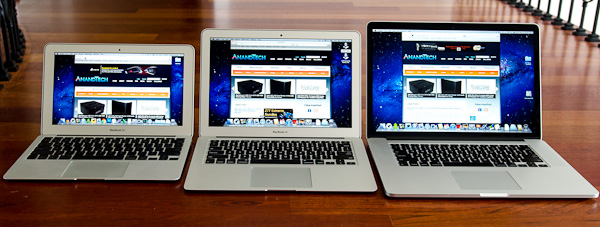
From left to right: 11-inch MacBook Air, 13-inch MacBook Air, MacBook Pro with Retina Display
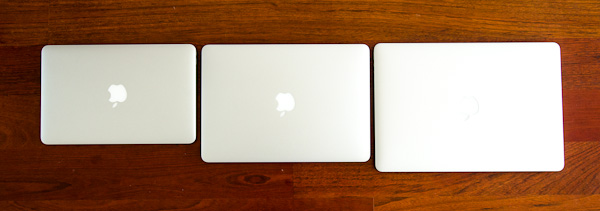
From left to right: 11-inch MacBook Air, 13-inch MacBook Air, MacBook Pro with Retina Display



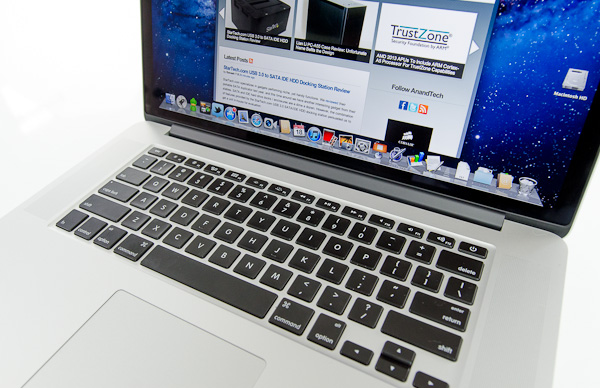
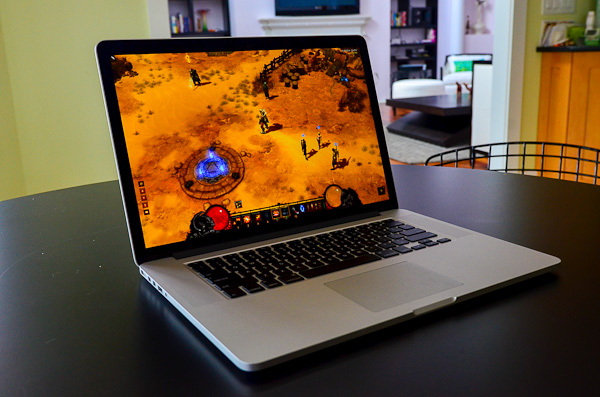
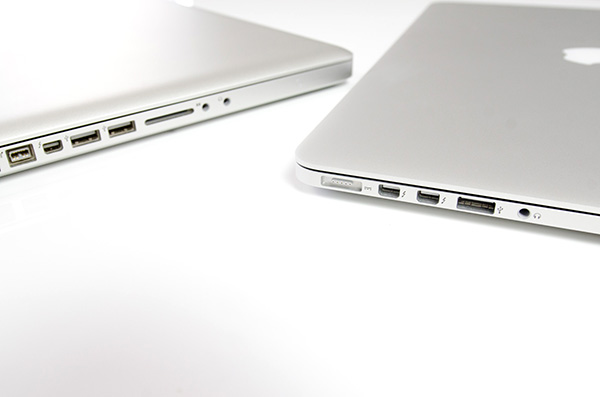
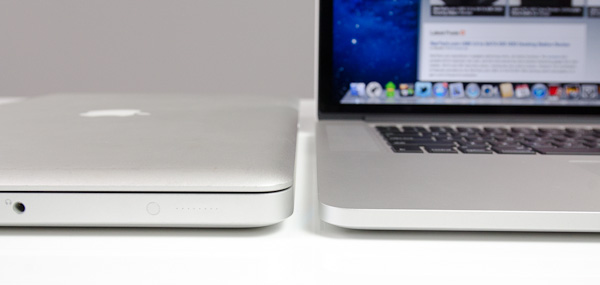








471 Comments
View All Comments
Penti - Saturday, June 23, 2012 - link
W8 doesn't change anything, having one setting for Metro and one for Desktop that works just like before doesn't cut it.Spoony - Saturday, June 23, 2012 - link
I don't think you've been understanding what I've been saying.Quartz is a fully resolution independent drawing layer. It can map to any pixel density necessary. It is incredibly fast and flexible, especially when tied in to technologies like Core Animation, Core Image, and Core Text.
It's also worth noting that Core UI exists in OS X, and has done since 10.5. This is a vector/texture baking engine that draws all interface elements in OS X in a fully resolution agnostic way. This is a very nice, and slick piece of software.
You do make a point, Apple keeps doing this 2x scaling thing. Why?
As it turns out, U/I scaling is a very complex thing. Not only is it a bit difficult to wrap your head around, it's a bit difficult to code against. Everybody isn't about to go build vector assets for their applications. Apple has to meet developers (and its own internal application teams, probably) halfway. Thus the @2x assets. It is a somewhat limiting, although fairly consistent and simple method for enabling bitmap creation in a resolution independent interface.
So you're wrong, OS X does have (and has had) support for full resolution independence. You can scale to your heart's content, from a 600dpi printer to a 72dpi display, at any interface factor.
The question is simply more complex than "does the slider work". Windows does not scale well at all, applications tear, refuse to scale, magnify far too much, render incredibly blurry images and text. The rendering layer is not versatile, nor set up for this kind of usage. Win8 improves matters, but not with as much depth as we'd have hoped.
ananduser - Sunday, June 24, 2012 - link
I know that Apple's Quartz engine is scaling capable the agnostic and traditional way. Just was never good at it for extreme scenarios; a common gripe with macusers demanding better implementation. Windows' similar mechanism was always more efficient especially since Vista(XP's sucked).3rd party apps that don't scale properly have only their devs to blame. I don't know your particular app use on Windows but I can say that you gripes with it are exaggerated or maybe translated from your OSX experience. Battle of the sliders is ultimately a question of correct dev use. 3dmark for instance makes use of their own trademark GUI that does not make use of Win resources. I've always hated that. So does itunes on WIndows or Safari. These will never work right.
The 2x scaling is a rigid compromise. It achieves consistency but not resolution independence. As I said before, resolution independence does not exist as it is idealistic in theory, and abstracts constraints such as scaling factors. If Apple pushes ahead with their low/normal/high scaling presets across their entire line-up, and in the process completely eliminates the notion of changing resolution(as in picking a number from a table) they will achieve a consistent experience like on ios; and it will still not be resolution independence "from a technical pov".
I'm arguing semantics and not the MBP-R which is a spanking machine.
Spoony - Sunday, June 24, 2012 - link
Lots of the software I use on Windows fails hard when you crank that slider up. Photoshop, Illustrator, SAP, iTunes (woe is me), Chrome, Office, etc... a vast majority of the software I want to use does not work correctly. Plus Win7 isn't exactly elegant about scaling artwork, even universal widgets get a little weird looking.And here I agree with you. 2x is rigid, it is not ideal, we would want to pick a resolution and then pick a U/I scaling value to get exactly the pixel density and U/I size that is ideal for our use. I would like that a great deal.
Unfortunately that's not the reality of designing interfaces today. We are moving into new territory here from an execution standpoint, and you can't just go vectorize all your assets and FP-define all of your layout coordinates and transforms overnight.
To make this work, Apple need to meet developers and users halfway. They need to make it simple for the user to select the most comfortable size for elements, while also providing a "we believe this is best" mode. They need to give developers a relatively straightforward way to develop assets for these higher resolution displays, and not force too much layout tweaking.
This is a transitional period. I believe Apple has struck a decent balance. A balance that works and will actually allow this to fly. It isn't the best of all worlds right now, but that day is coming. Certainly what Apple ships today is better than what Microsoft ships today. That difference will also be eroded by time.
ananduser - Sunday, June 24, 2012 - link
I noticed Anand's review update. Windows set on 200% increase, makes the desktop similar to OSX' retina setting. And furthermore Anand also stated that under this state Windows faces the same 3rd party related issues as OSX."To make this work, Apple need to meet developers and users halfway. " One modification...Apple needs to meet "their" developers and "their" users.
"Certainly what Apple ships today is better than what Microsoft ships today."
I'm not sure you want to go far as to compare 2 different OS architectures based on high res panel support alone. This is first and foremost a subjective discussion before an objective one.
ananduser - Sunday, June 24, 2012 - link
Win8 has the best high res support of the market. It's completely panel agnostic(11 inch all the way to Ballmer's wall TV). It's easy to diminish W8, but it is more of a step forward than Apple's traditional "small steps" policy.Spoony - Sunday, June 24, 2012 - link
Only in Metro mode.In "old-style desktop" mode it exhibits the same problems as Win7. So it will require developer effort in the same way Mac OS X will.
Windows 8 is well known to produce very polar reactions. The direction and momentum of Metro development is highly questionable right now. There are a lot of unanswered questions and not a lot of trust in Microsoft's path.
On the flip-side, Apple is shipping a high-res hardware product today with a clear and well known path to high-res execution today. They have a defined timeline to their next OS and a price tag attached. Everything is a known quantity here, and developer support is strong.
Windows 8 will be released in the fall sometime with a presently unknown price and an unknown vector to high-res asset curation.
This is not a post bashing Microsoft or adoring Apple (none of them were). I am plainly stating the way that two different companies have tackled a very complex issue at this moment in time. I deeply hope that Microsoft, Apple, Linux, and 3rd party developers all put forward competitive support for high resolution displays because they are the future, and I'd like to enjoy them.
ananduser - Sunday, June 24, 2012 - link
"Everything is a known quantity here." Apple's biggest advantage."I deeply hope that Microsoft, Apple, Linux, and 3rd party developers all put forward competitive support for high resolution displays" The potential issue is that they all put competitive efforts but different efforts. Each one goes their own way.
wendoman - Saturday, June 23, 2012 - link
That's why Intel QuickSync doesnt work on Mac's? LOLSpoony - Saturday, June 23, 2012 - link
"High-performance H.264 encoding3When you select a standard HD export setting, QuickTime Player takes advantage of hardware video encoding for optimal performance."
"Supported on the following Mac models: iMac (Mid 2011 or newer), Mac mini (Mid 2011 or newer), MacBook Air (Mid 2011 or newer), and MacBook Pro (Early 2011 or newer)."
http://www.apple.com/osx/whats-new/features.html
Apple does things when they're good and ready (for better or worse), and by the looks of things with Mountain Lion they're exposing QuickSync underneath AVFoundation or QTKit.